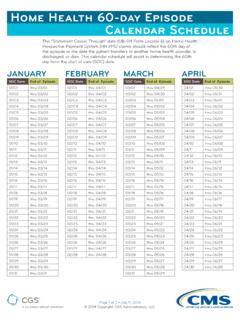Transcription of 11 Part B Billing Scenarios for PTs and OTs
1 Reviewed 9/2009 11 Part B Billing Scenarios for PTs and OTs The following Billing Scenarios formerly appeared on the Frequently Asked Questions (FAQ) website and on the Therapy Medlearn website as "11 FAQs" - posted 9/13/02 Open Door on Group Therapy. CMS Assumptions The following CMS assumptions were used in constructing the following Billing Scenarios regarding Part B therapy services. These represent requirements that are necessary pre-conditions to the information that follows and are part of the service delivery framework that CMS assumes is in place when Part B therapy services are delivered: Physical and Occupational Therapists (PTs and OTs) and their therapy assistants - physical therapist assistants (PTAs) and occupational therapy assistants (OTAs) meet Medicare personnel qualifications.
2 All therapy provided consists of skilled and medically necessary services and is appropriate to each patient's plan of care. Therapists can enroll in Medicare as providers of PT or OT services, but therapy assistants cannot. The services of the therapy assistant are billed through the enrolled therapist, or other therapy provider. The therapist reports the time the therapy assistant provides care, whether it is one-on-one care or delivered via the untimed codes, such as supervised modalities or group therapy. All Medicare rules are met with respect to supervision requirements for therapy assistants in their respective settings. For example: (1) direct ("in the office suite") supervision in private practice PT or OT therapy settings and (2) general supervision in the following settings: Outpatient Prospective Payment System, Skilled Nursing Facility, Comprehensive Outpatient Rehabilitation Facility, Rehab Agency and the Home Health Agency.
3 Each therapist's supervision of therapy assistant(s) is in compliance with all State laws and regulations and with local medical review policies. References The following references are used throughout the Billing Scenarios that follow: 1. Definitions of qualified therapy personnel: 42 , 2. Reasonable and necessary: Program Integrity Manual Chapter 13, Section 3. Skilled therapy: Benefits Policy Manual, 100-02, Chapter 15, Sections 220 and 230 4. CPT Definitions: CPT 2004, American Medical Association Press 5. Counting of timed codes: Claims Processing Manual, 100-04, Chapter 5, Section , and Program Memorandum AB-01-68 (May 1, 2001) 6. SNF Therapy: Federal Register, 66 Fed. Reg. 39567 (July 31, 2002) 7.
4 Correct Coding Initiative websites: o Physician Fee Schedule o Hospital Outpatient PPS 8. User's Manual for the Minimum Data Set (MDS) Version , Revised December 2008, Revised Long Term Care Resident Assessment Instrument: Reviewed 9/2009 1. Billing - CPT Codes: Not Permitted In the same 15-minute (or other) time period, a therapist cannot bill any of the following pairs of CPT codes for outpatient therapy services provided to the same, or to different patients. Examples include: a. Any two CPT codes for "therapeutic procedures" requiring direct one-on-one patient contact (CPT codes 97110-97542); b. Any two CPT codes for modalities requiring "constant attendance" and direct one-on-one patient contact (CPT codes 97032 - 97039); c.
5 Any two CPT codes requiring either constant attendance or direct one-on-one patient contact - as described in (a) and (b) above -- (CPT codes 97032- 97542). For example: any CPT code for a therapeutic procedure (eg. 97116-gait training) with any attended modality CPT code (eg. 97035-ultrasound); d. Any CPT code for therapeutic procedures requiring direct one-on-one patient contact (CPT codes 97110 - 97542) with the group therapy CPT code (97150) requiring constant attendance. For example: group therapy (97150) with neuromuscular reeducation (97112); e. Any CPT code for modalities requiring constant attendance (CPT codes 97032 - 97039) with the group therapy CPT code (97150). For example: group therapy (97150) with ultrasound (97035); f.
6 Any untimed evaluation or reevaluation code (CPT codes 97001-97004) with any other timed or untimed CPT codes, including constant attendance modalities (CPT codes 97032 - 97039), therapeutic procedures (CPT codes 97110-97542) and group therapy (CPT code 97150) See reference numbers 4. and 5. above. 2. Billing - CPT Codes: Permitted In the same 15-minute time period, one therapist may bill for more than one therapy service occurring in the same 15-minute time period where "supervised modalities" are defined by CPT as untimed and unattended -- not requiring the presence of the therapist (CPT codes 97010 - 97028). One or more supervised modalities may be billed in the same 15-minute time period with any other CPT code, timed or untimed, requiring constant attendance or direct one-on-one patient contact.
7 However, any actual time the therapist uses to attend one-on-one to a patient receiving a supervised modality cannot be counted for any other service provided by the therapist. See reference numbers 4. and 5. above. 3. Group Therapy vs. Individual Therapy: The following is provided to assist you in determining whether to bill for group therapy (97150) or individual therapy (defined by the timed CPT codes for therapeutic procedures requiring direct one-on-one patient contact), when treating two patients during the same time period. Reviewed 9/2009 When direct one-on-one patient contact is provided, the therapist bills for individual therapy, and counts the total minutes of service to each patient in order to determine how many units of service to bill each patient for the timed codes.
8 These direct one-on-one minutes may occur continuously (15 minutes straight), or in notable episodes (for example, 10 minutes now, 5 minutes later). Each direct one-on-one episode, however, should be of a sufficient length of time to provide the appropriate skilled treatment in accordance with each patient's plan of care. Also, the manner of practice should clearly distinguish it from care provided simultaneously to two or more patients. Group therapy consists of simultaneous treatment to two or more patients who may or may not be doing the same activities. If the therapist is dividing attention among the patients, providing only brief, intermittent personal contact, or giving the same instructions to two or more patients at the same time, it is appropriate to bill each patient one unit of group therapy, 97150 (untimed).
9 A. One-on-One Example: In a 45-minute period, a therapist works with 3 patients - A, B, and C - providing therapeutic exercises to each patient with direct one-on-one contact in the following sequence: Patient A receives 8 minutes, patient B receives 8 minutes and patient C receives 8 minutes. After this initial 24-minute period, the therapist returns to work with patient A for 10 more minutes (18 minutes total), then patient B for 5 more minutes (13 minutes total), and finally patient C for 6 additional minutes (14 minutes total). During the times the patients are not receiving direct one-on-one contact with the therapist, they are each exercising independently. The therapist appropriately bills each patient one 15 minute unit of therapeutic exercise (97110) corresponding to the time of the skilled intervention with each patient.
10 B. Group Example: In a 25-minute period, a therapist works with two patients, A and B, and divides his/her time between two patients. The therapist moves back and forth between the two patients, spending a minute or two at a time, and provides occasional assistance and modifications to patient A s exercise program and offers verbal cues for patient B s gait training and balance activities in the parallel bars. The therapist does not track continuous or notable, identifiable episodes of direct one-on-one contact with either patient and would bill each patient one unit of group therapy (97150) corresponding to the time of the skilled intervention with each patient. See reference numbers 4. and 5. above.












